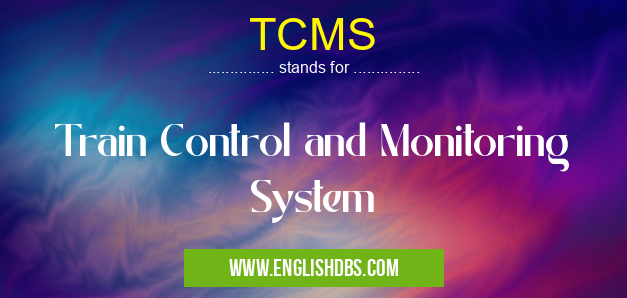What does TCMS mean in TRANSPORTATION
Train Control and Monitoring System (TCMS) is an advanced technological system employed for the control and monitoring of railway operations. The main purpose of these systems is to ensure the efficient operation of a railway network, no matter how large or small it may be. It does this by providing accurate information to its users in real-time, as well as ensuring the safety of staff and passengers alike.

TCMS meaning in Transportation in Governmental
TCMS mostly used in an acronym Transportation in Category Governmental that means Train Control and Monitoring System
Shorthand: TCMS,
Full Form: Train Control and Monitoring System
For more information of "Train Control and Monitoring System", see the section below.
Essential Questions and Answers on Train Control and Monitoring System in "GOVERNMENTAL»TRANSPORTATION"
What is a Train Control and Monitoring System (TCMS)?
A Train Control and Monitoring System (TCMS) is an advanced system used to control, monitor, and manage railway operations. It combines hardware and software solutions to provide operators with useful information about their trains, such as speed, location, direction, etc. TCMS can also be used to reduce the chances of collisions by automatically controlling the speed and route of the train.
What components are included in a TCMS?
A TCMS typically includes a range of components such as sensors, cameras, communication systems, trackside elements, onboard computers and displays. These components work together to provide train operators with useful information about their trains’ performance and environment.
How does a TCMS work?
The main purpose of a TCMS is to help ensure safe rail operation by providing real-time data that can be used to detect potential problems before they happen. Sensors gather data from trackside elements such as signals or other infrastructure devices. This data is then analyzed in order for it to detect any potential issues or accidents in advance so corrective actions can be taken quickly.
What are the benefits of using a TCMS?
By using a TCMS, rail operators can benefit from enhanced safety protocols that reduce the risk of accidents or collisions. In addition, it allows them to monitor key performance indicators more accurately which helps improve overall efficiency on the railway network. The use of advanced sensors also means that more detailed analysis can be performed which enables better decision making when managing rail operations.
Is there any additional technology integrated into a TCMS?
Yes - some modern TCMS solutions include analytics capabilities that allow operators to gain deeper insights into their operations such as predictive maintenance algorithms or asset monitoring tools. These features enable operators to save time while still ensuring maximum safety on the railway network.
How secure is a TCMs?
Security is an important factor for successful implementation of any kind of computer system on railways –including TCMs systems. To ensure secure communication between all parts of the process access control mechanisms are employed.Moreover, security checks for all elements in the system including hardware, software,communication links,and networks should be continuously maintained.
Are there any regulations associated with using a TCM?
Yes –there are regulations in place regarding using the underlying technologies within Train Control & Monitoring Systems. For example,in many countries there are laws that mandate electronic speed monitoring systems must be installed on board locomotives due to safety considerations. Similarly, EU directives require ERTMS (European Rail Traffic Management Systems) levels 2 or 3 for certain types of trains operating across national borders.
Final Words:
In conclusion, Train Control and Monitoring Systems (TCMS) have become essential components within modern railway networks due to their ability to provide accurate information both locally and globally regarding train activities while also helping keep operators informed during emergency situations on board trains or stations. With continuously evolving technology being introduced into this area, we can expect even greater capabilities from these systems in controlling and monitoring our rail networks more efficiently in the future than ever before.
